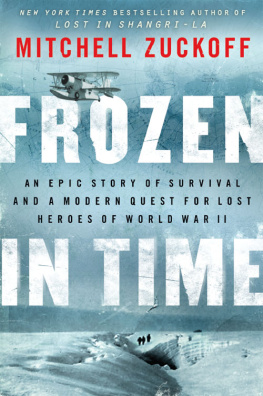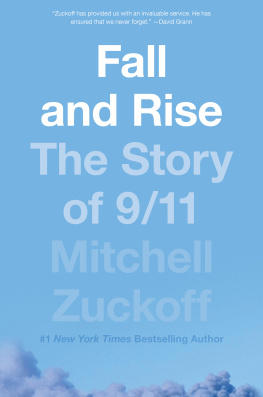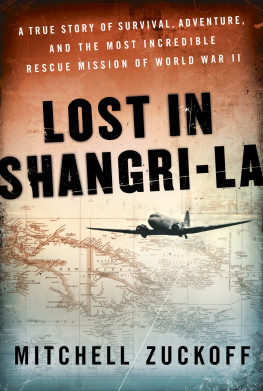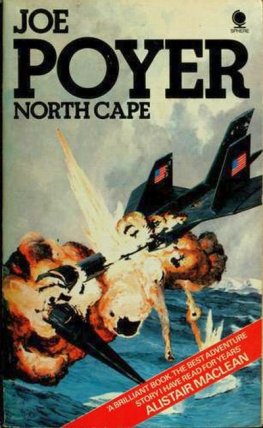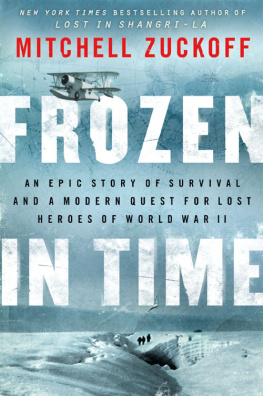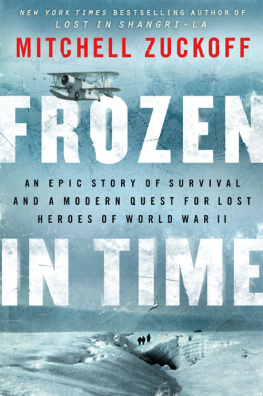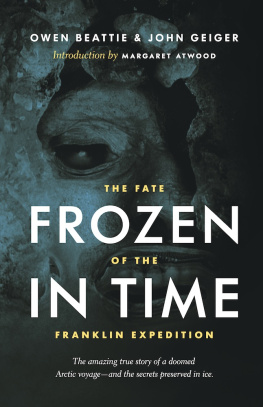T HIS BOOK TELLS two true stories, one from the past and one from the present.
The historic story revolves around three American military planes that crashed in Greenland during World War II. First, a C-53 cargo plane slammed into the islands vast ice cap. All five men aboard survived the crash, and their distress calls triggered an urgent search. Next to go down was one of the search planes, a B-17 bomber, stranding nine more men on the ice. Finally, a Coast Guard rescue plane called a Grumman Duck vanished in a storm with three men aboard while trying to save the B-17 crew.
For nearly five months, through the Arctic winter of 19421943, survivors and their would-be saviors fought to stay alive and sane in the most hostile environment on earth, clinging to life in snow caves and the tail section of the B-17. As the war raged on, Americas military tried to rescue the icebound men by land, sea, and air, sometimes with fatal results. When hope seemed lost, a legendary aviator from the early days of flight devised a half-mad plan to land a seaplane on a glacier.
I learned about these events while hunting through newspaper archives for hidden treasures: stories that once captivated the world, only to fall through the cracks of history. After too many brassiere ads to count, I came across a 1943 series of newspaper articles titled The Long Wait, about the crew of the wrecked B-17. Intrigued, I dug deeper, collecting declassified documents, maps, photographs, interviews, and previously unknown journals, seeking critical mass for a book.
Along the way, I stumbled upon a loose-knit society of men and women determined to locate the Grumman Ducks resting place and to bring home the remains of the three heroes it carried. Driving that effort was a tireless dreamer named Lou Sapienza, a photographer-turned-explorer who dedicated himself physically, financially, and emotionally to finding the frozen tomb of three men he knew only from faded photographs. Through Lou and his cohorts I met families whod been waiting nearly seven decades for the return of their lost loved ones.
I also connected with Duck-devoted Coast Guardsmen who believed that all hands should be present and accounted for, one way or another. One in particular, Commander Jim Blow, committed himself with the same fervor he once gave to his work as a search-and-rescue pilot. Soon I realized that I couldnt tell the full story of the three crashes without also writing about the modern mission of the Duck Hunt.
In the summer of 2012 I joined Lou, Jim, and their combined civilian and military teams on a remote glacier in Greenland, where we experienced the worlds unfinished attic firsthand. Together we used cutting-edge technology, an overlooked military crash report, and a yellowed treasure map complete with an X to solve one of the last mysteries from World War II.
Although written as a narrative, this is a work of nonfiction. As explained in my note on sources, I took no liberties with facts, dialogue, characters, details, or chronology. Because the story moves between past and present, date markers such as November 1942 and October 2011 signal which tale is being told. Also, the historical story is written in past tense, while the modern story is in present tense.
I played a role in the Duck Hunt, and I appear in the book, but it isnt about me. Its about ordinary people thrust by fate or duty into extraordinary circumstances, one group in 1942 and another group seventy years later. Separated by time but connected by character, their bravery, endurance, and sacrifices reveal the power of humanity in inhumane conditions. I hope Ive done them justice.
Mitchell Zuckoff
I TS A POWERFUL and unsettling experience to be drawn into the orbit of someone possessed by an impossible dream. At times I wondered if Lou Sapienza would awake and abandon his quixotic plan to find three airmen entombed in a glacier. Or maybe hed suffer one too many sacrifices and surrender to self-preservation. But no matter how many setbacks Lou faced, nothing deterred him. The Duck Hunt expedition was the accomplishment of a rare and remarkable man. If Im ever lost, I hope that Lou decides that I need to be found.
Im profoundly indebted to Commander Jim Blow of the U.S. Coast Guard. He made countless essential contributions to the Duck Hunt and to this book, and he welcomed me on the mission with respect and kindness. I admire his leadership and value his friendship. As I say elsewhere, hes a gentleman.
Deep thanks to all my expedition mates, several of whom offered valuable comments on the manuscript. I hope that the friendships we made will endure as long as the memories. In alphabetical order: Alberto Behar, John Bradley, Nick Bratton, Michelle Brinsko, Jetta Disco, Jaana Gustafsson, Ken Harman, Steve Katz, Terri Lisman, Frank Marley, Ryan Sapienza, Bil Thuma, and Rob Tucker. A special shout-out to my friend Robert WeeGee Smith, with whom I shared one of the most extraordinary moments of my life.
Retired master chief petty officer John Long was a tireless researcher and an unflagging advocate for the families of John Pritchard, Ben Bottoms, and Loren Howarth. This book is marbled with his insights and contributions.
Three retired Coast Guard captains played key roles in this book. Don Taub spent years investigating these events: he tracked down participants, analyzed innumerable documents, and corrected mistakes made in earlier accounts. Thomas C. King Jr., who kick-started the Duck Hunt, provided essential help as I began this project. Charles Dorian sent me the rare photographs he took as an ensign aboard the Northland during the fall of 1942. His tales of life aboard ship were invaluable.
Im thankful to the family members of the heroes whose stories are told here. Trusting me with their loved ones reputations, they shared documents, photos, and insight into these remarkable men. Thank you, Nancy Pritchard Morgan Krause, who brought to life her late brother, John Pritchard; Edward Bud Richardson, who reached into his childhood memories to describe his stepfather, Benjamin Bottoms; and Marc Storch and Jerry Howarth, who shared stories of Loren Howarth.
Thanks also to Pete Tucciarone, who told me loving anecdotes about his father, Alexander Al Tucciarone; Reba Greathead and Eric Langhorst, who enlightened me about her father and his grandfather-in-law, Clarence Wedel; Robert Best, who made me feel as though I knew his father, Alfred Clint Best; Jean Gaffney, daughter of Paul Spina, who shared his priceless forty-page account of his ordeal; Patricia OHara, daughter of William Bill OHara, who regaled me with tales of his toughness; Nancy Dunlop, daughter of PBY pilot Bernard Dunlop; and Carol Sue Spencer Podraza, daughter of Harry Spencer, whose vivid stories and delightful way of telling them made every conversation a pleasure.
Among the historians, librarians, and archivists who helped me were two who went above and beyond: Coast Guard historian Robert M. Browning Jr., PhD, and William H. Thiesen, PhD, Atlantic Area Coast Guard historian. Thanks also to Martina Soden of the Scranton, Pennsylvania, Public Library; Karen Kortbein of the Wausaukee, Wisconsin, Public Library; and Mark C. Mollan, archivist in the Navy/Maritime Reference section at the National Archives and Records Administration. My graduate assistant, Sarah Testa, devised a filing system for my research that imposed order on chaos. Thanks to Evan Caughey for creating a sparkling website.
Chuck Greenhill, owner of the last flying Grumman Duck model J2F-4, and Duck enthusiast Bill Floten shared their deep knowledge of the wonderful little plane. In Aaron Bennet, Lou Sapienza found a true partner and a match for his relentlessness. Deep thanks to Jim and Nancy Bildner, who generously supported this effort.
Every author should have Richard Abate as an agent. Actually, scratch that, because then Id have to wait longer for his wise counsel and great humor. His contributions to this book and to my career are too many to list. Theres no female equivalent of mensch , so I propose claire , as long as its first applied to my editor, Claire Wachtel. Im only sorry that she didnt join me on the ice.
Next page
